Oldham Corporation Tramways
History
Oldham Corporation became a tramway owner on the 1st November 1880, when services started over its newly built standard-gauge lines; these were, however, not worked by the corporation, but were instead leased to the Manchester Carriage and Tramways Company (a horse-tramway operator). The embryonic system totalled 4.96 miles, comprising: a line running from the borough boundary at Springhead in the east, through the centre of Oldham and then southwestwards to the borough boundary at Failsworth; and a loop line within the centre of Oldham running to the south of the main line.
A second set of lines were opened on the 1st August 1885; these were also standard gauge, but were leased to the Manchester, Bury, Rochdale and Oldham Steam Tramways Company, which operated a large system centred on the towns in its title, with the notable exception of Manchester, which it never reached (the city was dropped from the company name in 1888). The steam-operated lines within Oldham comprised 3.21 miles as follows: a line from the borough boundary at Royton in the north, running southwards to the boundary with Limehurst Rural District Council at Fir Tree Avenue; and a line running from a junction with the main line on Rochdale Road, southwestwards along Featherstall Road North and South to meet the horse tramway at Manchester Road.
In 1898, Oldham Corporation successfully sought powers to construct and operate its own standard-gauge, overhead electric tramway system, the first line opening on the 15th December 1900, with others following in quick succession. The MC&TCo's lease expired on the 31st October 1901, with the horse-drawn services being immediately withdrawn so that conversion to electric traction could begin. Although the BR&OSTCo leases had expired on the same date, agreement was reached for the company to continue operating the steam services between Royton and West Street pending their conversion. The last steam tram ran on the 28th June 1902.
The tramway initially had a difficult time financially, largely because it had cost significantly more to build than had been anticipated, which meant that for nine of the first thirteen years, significant operating surpluses became overall losses due to servicing the large debts.
Oldham began experimenting with bus operation as early as the 12th May 1913, though it was only on a very limited scale. Like many tramways, the OCT emerged from the Great War with a significant backlog of track and car maintenance, both of which had suffered tremendously under the heavy wartime loadings and inability to replace life-expired components. Despite these challenges, the corporation found the money to invest in the system, which continued to thrive, ensuring that the tramways were in a position to take on the unregulated bus competition of the mid 1920s, which included the introduction of corporation bus services.
The tramway system was itself expanded in 1925 when the Middleton Electric Traction Company was acquired by the three local authorities in whose areas the system operated (Rochdale and Middleton Corporations, and Chadderton Urban District Council). The latter immediately sold its share of the METCo (1.66 miles) to Oldham Corporation, which commenced through services to Middleton on the 9th August 1925. That same month, the corporation introduced a joint but short-lived trolleybus service — between Oldham and Ashton — together with Ashton-under-Lyne Corporation Tramways. This began on the 26th August 1925, but due to continual difficulties with vibration (over the cobbled roads), operation in Oldham was brought to an end on the 5th September 1926.
Despite the tramway continuing to make a profit during the late 1920s, expensive track renewals resulted in the first abandonment (the line to Lees on the 1st May 1928), which was quickly followed by the line to Grains Bar on the 23rd December 1928). These abandonments reflected a change in policy, the corporation having formally decided to abandon the system in favour of buses (as and when track renewals made the switch advisable) in early 1927.
The bus services were steadily expanded during the early 1930s, years which also saw Manchester Corporation run its last tram to Middleton (on the 23rd March 1932) and Rochdale Corporation completely abandon its tramway system (on the 12th November 1932). The name of the enterprise was changed in August 1933 — to Oldham Corporation Passenger Transport — to reflect the increasing number of bus services. Further tramway routes were abandoned over the course of the 1930s, with just two routes left (totalling 5 miles) by the outbreak of the Second World War. The conflict led to an inevitable reprieve for the oil-independent trams, but withdrawal resumed immediately after the war, the last tram running on the 3rd August 1946.
At its maximum, the system extended to 25.93 miles, including 0.36 miles owned by Lees UDC, 1.48 miles by Crompton UDC, 4.08 miles by Royton UDC, and 1.66 miles acquired from Chadderton UDC in 1925. The system comprised lines: northwards to Summit; northeastwards to Shaw (via Royton and via Higginshaw) and Grains Bar; eastwards to Waterhead and to Lees; southwards to Hathershaw; southwestwards to Hollinwood (via Manchester Road and Hollins Road); and westwards to Mills Hill.
The tracks of the OCT met those of Rochdale Corporation Tramways at Summit, those of Manchester Corporation Tramways at Hollinwood, those of the Oldham, Ashton and Hyde Electric Tramways Company at Hathershaw, and those of the Middleton Electric Traction Company at Werneth (Featherstall Road). The tracks at Summit were connected up, and a joint OCT/RCT service was introduced between Hathershaw and Norden (to the northwest of Rochdale) on the 1st May 1906. Although the OCT and the MCT tracks were physically connected at Hollinwood, the tracks there were not owned by the MCT, but were leased from Failsworth UDC, who took umbrage at this step, as well as its exclusion from discussions with the OCT on through running. The municipal differences were eventually resolved, and through-running began on the 21st January 1907 between Manchester Piccadilly (Stevenson Square from the 4th August 1910) and Waterhead, via Hollinwood.
During company days, no connection was made between the tracks of the OCT and either the OAHETCo or the METCo; however, following both companies acquisition by the local authorities (in 1921 and 1925, respectively) connections were put in. The connection at Hathersaw resulted in a joint service involving the OCT and the new owners of the former OAHETCo tracks (Ashton-under-Lyne Corporation Tramways), which commenced running between the Star Inn in Oldham and Ashton Market Place on the 2nd July 1921. As mentioned above, the connection to the tracks of the former METCo at Werneth resulted in a through service to Middleton from the 9th August 1925.
Uniforms
Staff working the new electric services, which commenced in 1900, were issued with single-breasted jackets with five buttons (presumably brass — see link), stand-up collars and epaulettes. The bearer's right-hand collar bore system initials — 'O C T' — in individual letters, whilst the left bore an employee number in individual numerals; the epaulettes, which were fastened at the neck end with a button, carried a small municipal-device badge. The tensioned-crown, peaked caps bore a script-lettering grade badge — either 'Motorman' or 'Conductor' — above which a municipal-device badge was worn (the same pattern as worn on the epaulettes). All the badges were probably brass initially. In the late-Edwardian era, the collar insignia were altered such that the employee number was now worn on both sides; the number being preceded by a letter, 'C' in the case of conductors, and 'M' in the case of motormen.
At some point prior to the Great War, probably in 1912/13, the grade and municipal-device badges were replaced by a single more elaborate cap badge, which comprised the municipal-device and motto within a wreath, but without a title of any kind. Motormen's jackets were probably changed at the same time to a double-breasted, lancer-style with five pairs of buttons (narrowing from top to bottom) and stand-up collars; the latter carried the same insignia as previously. These tunics, as well as those worn by conductors, were initially without epaulettes, though later photos show them with. A final change was made in the mid 1930s to a more modern-looking, double-breasted design with four pairs of buttons and lapels; it is currently unclear what insignia the latter bore.
Oldham Corporation Tramways buttons have survived in brass and nickel, and the larger wreath cap badges in brass, nickel and chrome. It is likely that the first issues were in brass, with a transition to nickel at some point, possibly when the uniforms and cap badges were changed shortly before the Great War. As the name of the undertaking was changed to Oldham Corporation Passenger Transport in 1933, new uniform issues after this would have borne O C P T insignia and buttons, and these would initially have been nickel, subsequently being switched to chrome.
Tramcar crews were also issued with long, double-breasted greatcoats with five pairs of buttons, high fold-over collars (without insignia) and epaulettes; the latter were closed with a button, and carried the same insignia as the jacket epaulettes worn underneath.
Long service was reflected by the issue of an elaborate brass badge comprising the municipal device and motto, within a garter containing the full system title — 'OLDHAM CORPORATION TRAMWAYS' — inlaid with blue enamel and surmounted by a wreath; this was probably issued after 5-years of service. An embellished version was issued for 10-years of service (with a more elaborate wreath and red inlay), with 15 and 20-years of service marked by the addition of one and two stars, respectively (worn above and below the long-service badge); it is currently unclear where the stars were placed, but probably above and below the badge itself. The 25-years' version was made from sterling silver rather than brass. Photographs indicate that these badges were worn on the bearer's upper left jacket sleeve. In later years (probably from the mid 1930s onwards), the material was changed to chrome, and given that they also exist in 'OLDHAM CORPORATION TRANSPORT' form, it is probable that tramcar staff were issued with these in later years, rather than the 'Tramways' version.
Inspectors were issued with fairly standard uniforms for this grade, namely: single-breasted jackets with hidden buttons (or more likely a hook and eye affair) and stand-up collars; the jackets were edged in a finer material than the jacket itself, with the bearer's right-hand collar (only) bearing metal system initials — 'O C T' — very probably in brass. The caps were initially of the drooping-peak type; they bore a municipal-device badge above a script-lettering grade badge — 'Inspector' — both probably brass. By the mid-Edwardian era, the drooping-peak caps had been superseded by tensioned-crown peaked caps; these continued to bear the same cap badges as previously, but with the script-lettering grade badge possibly being embroidered rather than metal. It is currently unclear what uniforms were worn by senior staff after the late-Edwardian era.
During the Edwardian era, inspectors were also issued with double-breasted greatcoats with lapels; the collars of these garments appear to have borne metal system initials on both sides.
In common with many UK tramway systems, Oldham employed female staff during the Great War to replace men lost to the armed services. These ladies were issued with single-breasted, tailored jackets with four buttons, a waist belt with two buttons, lapels and epaulettes, along with matching knee-length skirts and gaiters. The jackets appear to have been devoid of insignia, with the possible exception of the epaulettes. Long, single-breasted top coats were also worn; these had five buttons, off-set to one side, high fold-over collars (without insignia) and epaulettes. The latter were fastened with a button and carried an employee number preceded by a 'C'. Headgear took the form of a bonnet that was worn with one side pinned up, reminiscent of Australian slouch hats, with the standard municipal wreath cap badge worn on the underside of the pinned-up side.
Further reading
For a history, see 'Oldham Corporation Tramways' by Arthur Kirby; Triangle Publishing (1998).
Images
Motormen and conductors
A studio portrait of an Oldham Corporation Tramways conductor (Employee No 262) — photo undated, but probably taken around the time the first electric services were introduced (late 1900 onwards). The badges would presumably have been brass to match the buttons. Author's Collection.
An Oldham Corporation municipal-device badge — brass. This badge was worn on the caps between 1900 and circa 1912/13, and on the epaulettes throughout the life of the tramway. Author's Collection.
Standard off-the-shelf script-lettering grade badges of the type used by Oldham Corporation Tramways from 1900 to circa 1912/13 — brass. Author's Collection.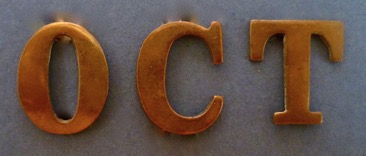
OCT collar initials — brass. Author's Collection.
A studio portrait of Conductor Edwin Goddard taken in 1903; he was employed from 1903 to 1913, most of that time as a motorman. Studios of Wright & Co, 6, Union Street, Oldham. With thanks to John Holmes.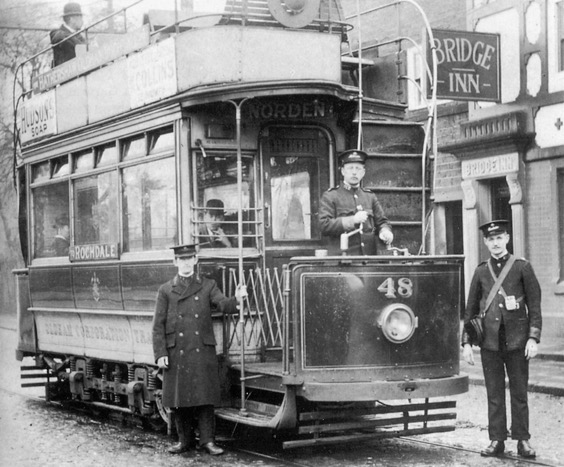
An inspector, a conductor and a motorman pose with Tramcar No 48 at the Norden terminus in Rochdale — photo undated, but probably taken within a few years of this service commencing (1st May 1906). Photo courtesy of the Tramways and Light Railway Society, with thanks to David Voice.
An enlargement of the above photograph showing the motorman and the conductor.
A group of OCT conductors and motormen pose for an informal shot in Wallshaw Place outside the tramway depot — photo purportedly taken in 1910. Stephen Howarth Collection.
The crew of Tramcar No 90 captured for posterity at the top of Copsterhill Road — photo undated, but probably taken within a couple of years of No 90's delivery in 1911. Author's Collection.
An enlargement of the above photograph showing the conductor. His collars have his employee number on both sides ('197'), preceded by a 'C', all in individual numerals/letters.
Another shot at the top of Copsterhill Road, this time of Tramcar No 42, but taken somewhat later, probably shortly before the Great War. By this time, the earlier cap badges had been replaced by a prominent, though unmarked (i.e., no system title), cap badge comprising the Oldham municipal device and motto, surrounded by a wreath. The motorman is wearing a lancer-style tunic which is without epaulettes, as is the conductor's jacket. Stephen Howarth Collection.
An Oldham municipal-device cap badge — brass. These badges were used on tramway crew caps from around 1912/13 through to closure, though the material eventually changed to chrome, and possibly transitioned through nickel. Stephen Howarth Collection.
Tramcar No 99 at Grains Bar on Route No 5, which opened on 4th June 1914 — photo undated, but given the pristine condition of the tram (it was new in 1913), very likely taken in late 1914 or early 1915. Stephen Howarth Collection.
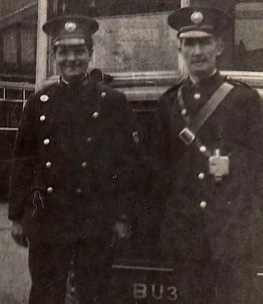
Motorman Laurie Kenworthy with his conductor, first on Tramcar No 44 in the early 1920s and then on a trolleybus in 1925. In the right-hand shot, he is clearly wearing a badge on the upper left arm of his tunic, almost certainly a long-service badge (see below). With thanks to John Holmes
A conductor and a motorman pose with Tramcar No 96 at Mills Hill on Route No 3 — photo dated 19th December 1934. The motorman is once again wearing a long-service badge on the upper left arm of his tunic, with stars above and below, denoting 20 years' service. Photo courtesy of the Tramways and Light Railway Society, with thanks to David Voice.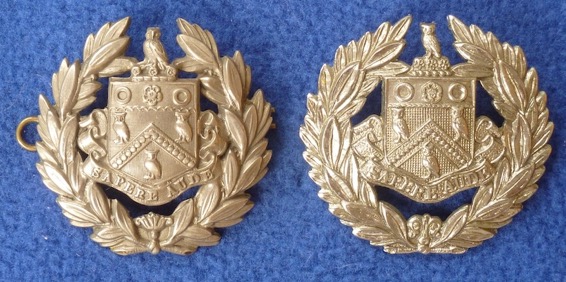
Oldham Corporation Tramways cap badges — nickel (left) and chrome (right). It is unclear whether the former material was used on tramway crew caps, but if so, possibly during the 1920s and 1930s. Chrome badges were probably introduced in the late 1930s or early 1940s. Author's Collection.
Oldham Corporation Tramway Employees Military Band — photo undated, but very probably mid-to-late Edwardian. The uniforms and caps appear to be bespoke items specially made for the band. Photo courtesy of the Stephen Howarth Collection.
Long Service Badges
Oldham Corporation Tramways long-service badge — brass with blue enamel. These were worn on the bearer's upper left jacket sleeve and were probably issued after 5 years of service.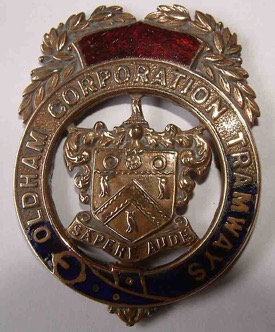
Oldham Corporation Tramways 10-years' long-service badge — brass with red and blue enamel. These badges were also used for 15- and 20-years' service, but embellished by the addition of one and two stars, respectively. With thanks to John Holmes and Stephen Howarth for the photo and background information.
Oldham Corporation Tramways/Transport long-service stars — nickel. Each star denoted an extra five years service on top of the ten years denoted by the badge; they were worn on the jacket sleeve, probably above and below the long-service badge. Photo courtesy of the National Tramway Museum.
Oldham Corporation Tramways 25-years' long-service badge — silver and blue enamel.
The rear of the above 25-years' long-service badge, showing the hallmark. The latter indicates that the badge was made by W, Dowler & Sons in 1912; if these badges were indeed issued for 25 years service, then this would suggest that prior service elsewhere in the corporation, or possibly on the trams of the Manchester Carriage and Tramways Company, was taken into account, Oldham only having begun to operate trams in 1900.
Oldham Corporation Tramways 5-years' long-service badge — chrome with blue enamel. This was possibly issued from the mid-1930s onwards when chromium plating came into wider use (see link).
Senior staff
A staff photo taken at an unidentified depot, around the time of opening, i.e., 1900/1. The photo includes five inspectors, who are standing at the extreme left (front row). Photo courtesy of the Stephen Howarth Collection.
An enlargement of the above photograph showing the inspectors. They are all wearing typical 'tramway inspector' garb, including drooping-peak caps that bear a municipal-device badge, along with what appears to be a metal script-lettering grade badge.
A script-lettering grade badge — 'Inspector' — brass, of the type used by Oldham Corporation Tramways. Author's Collection.
An OCT inspector, taken from the photograph of Tramcar No 48 above — photo undated, but probably lmid-to-late Edwardian. By this time, the drooping-peak caps had clearly been displaced by tensioned-crown peaked caps.
Female staff
A poor-quality, but rare photograph of an Oldham Corporation Tramways Great War conductress wearing a jacket rather than a top coat. The photograph was taken in 1915, and the subject was a Miss Bielby. Her uniform jacket appears to be devoid of insignia, save perhaps, for the epaulettes. Photo courtesy of the Stephen Howarth Collection. 
An Oldham Corporation Tramways Great War conductress. Author's Collection.
A studio portrait of four Oldham conductresses — photo undated, but certainly taken during the Great War. The lady on the right is probably wearing a make-shift hat as it appears to be fur or faux fur. Author's Collection.
An enlargement of the above photograph showing the lady on the left. The epaulette insignia, 'C 944' are easily made out. The badge on her left-hand collar is almost certainly a regimental sweetheart badge, in this case, possibly the Grenadier Guards.
A group of Oldham Corporation Tramways Great War conductresses. With thanks to John Holmes.
A studio portrait of a lady called Alice, who was very probably an Oldham Corporation Tramways Great War conductress. Author's Collection.